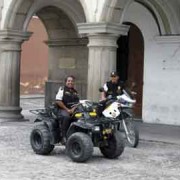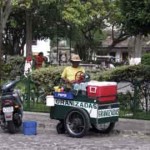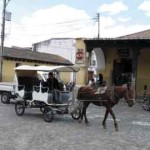Postcards from the Park
text/photos by Melba Milak
The city of La Antigua Guatemala is laid out in a simple grid: seven avenues running north and south and 10 streets going east and west. In the center of town is a park (Plaza Mayor), the heart and soul of the whole area.
The atmosphere in the park is carefree and carnival-like. When visiting Antigua, I come here two or three times a day—after breakfast and at least once again in the afternoon—to relax, gather my thoughts and people watch. I feel safe here; there are policía everywhere—on scooters and on foot, in pairs, usually one man and one woman. It is pretty and green on the park grounds; flowers bloom in soft lavenders or brilliant shades of yellow and red; gardeners work daily weeding and pruning and whacking at the grass with machetes.
On each corner, a vendor with a helado (ice-cream) cart sells cones and drumsticks. A man in a straw hat sells flavored ices from his granizadas cart. More vendors on the east side of the plaza sell fruit—colorful mouth-watering slices of melon and pineapple and papaya.
Every day when school is over, many students—still in uniform (white shirts; plaid skirts for girls and navy blue slacks for boys)—come to the park to laugh and joke and celebrate the schoolday’s end with noise and play. Individuals cut through the park on a catty-cornered path to someplace else.
Families come to eat ice-cream cones or sit under the tall shade trees to spend time together—out of the house, not in front of a television—or to talk on the cell phone. I am always amazed to see indigenous women, dressed in the centuries-old traditional Mayan clothing, pull a cell phone from the folds of their huipiles (blouses) and make a call.
Tourists—in all forms from all corners of the world—form groups and laugh and chatter in their own language. Couples engage in serious conversation or serious kissing.
It is quiet in the park but not silent. Small radios and tape players send Latino beats into the air; I saw a Guatemalan-style band (an accordion, two guitars and a singer who sang slightly out-of-tune) playing for quetzales. One afternoon a band sat at the Palacio Capitanes on the south side and oom-pahed through a concert of brassy marching music.
A horse-drawn wagon clip-clops along on the cobblestone streets and offers city tours.
A fleet of taxis waits for fares on the east side of the park in front of the Cathedral.
One of the joys of being in La Antigua is to come to the park; I do not feel so alone, but actually feel like I’m part of the community for a few days—not only by the Maya women and children trying to sell me hand-made jewelry or by the shoeshine boys giving my shoes the once-over and pleading for a chance to “shoo-shine them up”—but by individuals and families who are smiling and friendly and very affectionate with their children.
We all want to be here to bask in the splendor of the fountains and the flowers and the care-free hours.









